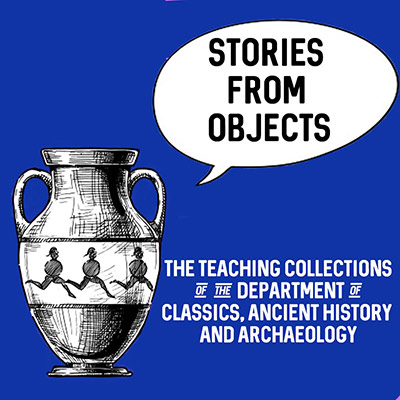
We are very pleased to present the next episode in our new podcast series Stories from Objects: the Teaching Collections of the Department of Classics, Ancient History and Archaeology. The podcast involves academics and students talking about different objects in CAHA’s teaching collections. Over the course of the series, we will cover topics such as Roman coins, animal bone, Greek pottery, and Egyptian shabtis and much more. We hope these podcasts will introduce the collection to a wider audience, and listeners will enjoy learning these stories from objects.
Joining Dr Maeve McHugh, Emily Gershman and Hebe Barlow for this month’s episode of Stories from Objects is Dr David Smith. In this episode, Dr Smith introduced us to the field of environmental archaeology and how the study of animal remains can aid our understanding of the past.

Dr Maeve McHugh, Emily Gershman and Hebe Barlow were joined by Dr David Smith for this episode.
Dr Smith opened the episode by discussing the role of entomology in archaeological research. He explained that insects may not be the first thing one thinks of in relation to the field of archaeology, but they are a key piece of evidence that allows us to reconstruct ancient environments and past living conditions.
During the episode, Dr Smith spoke about the Environmental Archaeology Collection we have in the Department, which is used regularly in teaching. It was fascinating to learn about his experiences of collecting samples for the collection and his encounters with a herd of wild cattle in northern England!

Dr Smith talks about a skull from the Chillingham cattle herd. The oldest wild herd of cattle in England.
He also brought in a very special sample to discuss from an ongoing archaeological project run by the Department. It was really interesting to learn about all the things one sample can tell us about ancient environments and peoples.

Hebe and Emily inspecting samples of animal bone from the Environmental Archaeology Collection
It was truly fascinating to hear Dr Smith talk through his work with animal bones, and it made us realise how much these remains can actually tell us, which is much more than we could have imagined. He gave an interesting comparison between the different kinds of cow and cattle remains upon the table, explaining key differences between their bone structures and what each difference could mean. We learned a great deal about the significance of animal remains in piecing together the lives of past communities and their habits, as well as laughing at some of Dr Smith’s anecdotes.
This podcast provides a wonderful introduction to the field of environmental archaeology and the importance of working with various animal remains in order for us to have a fuller understanding of what the world used to look like.
CAHA Archaeology Collection Volunteers